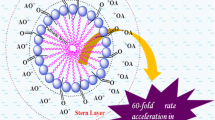Abstract
The kinetics and mechanism of the CrVI oxidation of ethane-1,2-diol in the presence and absence of picolinic acid (PA) in aqueous acid media have been carried out under the conditions: [ethane-1,2-diol]T ≫ [CrVI]T and [PA]T ≫ [CrVI]T at different temperatures. The micellar effect on the title reactions has been studied in order to substantiate the suggested mechanism. Under the experimental conditions, ethane-1,2-diol is predominantly oxidised to hydroxyethanal and the kinetic contribution from the glycol splitting path is negligible. In the absence of PA, the simple alcohol oxidation mechanism, involving one —OH group, operates. In the PA-catalysed path, a CrVI–PA cyclic complex has been proposed as the active oxidant. In the PA-catalysed path, the CrVI–PA complex is the subject of nucleophilic attack by the substrate to form a ternary complex which subsequently experiences a redox decomposition (through 2e transfer) leading to hydroxyethanal and the CrIV–PA complex. The CrIV–PA complex then participates further in the oxidation of organic substrate and ultimately is converted into the inert CrIII–PA complex. It is striking to note that the uncatalysed path shows a second-order dependence on [H+], while the PA-catalysed path shows a zeroth-order dependence on [H+]. Both the uncatalysed and PA-catalysed paths show first-order dependence on [ethane-1,2-diol]T and on [CrVI]T. The PA-catalysed path is first-order in [PA]T. All these observations (i.e. dependence patterns on the reactants) remain unaltered in the presence of externally added surfactants. The effect of the cationic surfactant (i.e. cetylpyridinium chloride, CPC) and anionic surfactant (i.e. sodium dodecyl sulfate, SDS) has been studied both in the presence and absence of PA. CPC acts as an inhibitor and restricts the reaction to aqueous phase, while SDS acts as a catalyst and the reactions proceed simultaneously in both aqueous and micellar phase, with an enhanced rate in the micellar phase. The observed micellar effects have been explained by considering the preferential partitioning of the reactants between the micellar and aqueous phase. The applicability of different kinetic models, e.g. the Menger–Portnoy model, Piszkiewicz cooperative model, pseudo-phase ion exchange (PIE) model, has been tested to explain the observed micellar effects.
Similar content being viewed by others
References
A.C. Chatterjee and S.K. Mukherjee, Z. Phys. Chem., 207, 372 (1957); (b) A.C. Chatterjee and S.K. Mukherjee, Z. Phys. Chem., 208, 281 (1958); (c) A.C. Chatterjee and S.K. Mukherjee, Z. Phys. Chem., 210, 166 (1959); (d) A.C. Chatterjee and S.K. Mukherjee, Z. Phys. Chem., 210, 255 (1959); (e) A.C. Chatterjee and S.K. Mukherjee, Z. Phys. Chem., 228, 166 (1965); (f) J. Rocek and F.H. Westheimer, J. Am. Chem. Soc., 84, 2242 (1962); (g) P.R. Bontchev, A. Malinovski, M. Mitewa and K. Kabassonov, Inorg. Chim. Acta, 6, 499 (1972); (h) P.S.C. Rao, D. Suri, S. Kothari and K.K. Banerjee, Int. J. Chem. Kinet., 30, 285 (1998).
T.Y. Peng and J. Rocek, J. Am. Chem. Soc., 98, 1026 (1976); (b) T.Y. Peng and J. Rocek, J. Am. Chem. Soc., 99, 7622 (1977); (c) C. Srinivasan, S. Rajagopal and A. Chellamani, J. Chem. Soc., Perkin. Trans., 2, 1839 (1990); (d) A.K. Das, Inorganic Reaction Mechanisms, 1, 161 (1999); (e) A.K. Das, S.K. Mondal, D. Kar and M. Das, J. Chem. Res. (S)., 574 (1998); (f) A.K. Das, S.K. Mondal, D. Kar and M. Das, Int. J. Chem. Kinet., (in press); (g) A.K. Das, S.K. Mondal, D. Dar and M. Das, Inorganic Reaction Mechanisms, (in press).
A.K. Das, Oxid. Commun., (communicated).
F. Feigl, Spot Tests in Organic Analysis, Elsevier, 5th edit., 1956; (b) M. Vishnoi, K. Sharma and R.N. Mehrotra, Int. J. Chem. Kinet., 23, 377 (1991); (c) J.F. O'dea and R.A. Gibbons, Biochem. J., 55, 580 (1953).
cf. V.M.S. Ramanujam, N. Venkatasubramanian and S. Sundaram, Aust. J. Chem., 30, 325 (1977) and the Refs. cited therein.
cf. (a) F. Hasan and J. Rocek, Tetrahedron, 30, 21 (1974); (b) J. Rocek, Collect Czech. Chem. Commun., 25, 1052 (1960); (c) M. Rahman and J. Rocek, J. Am. Chem. Soc., 93, 5455 (1971).
J.F. Perez-Benito, C. Arias and D. Lamrhari, J. Chem. Soc., Chem Commun., 472 (1992); (b) J.F. Perez-Benito and C. Arias, Can. J. Chem., 71, 649 (1993).
W. Watanabe and F.H. Westheimer, J. Chem. Phys., 17, 61 (1949).
cf. F.W. Billmeyer, Textbook of Polymer Science, Wiley, New York, 1984, p. 85.
A.C. Chatterji and S.K. Mukherjee, J. Am. Chem. Soc., 80, 3600 (1958); (b) T.J. Kemp and W.A. Waters, Proc. Roy. Soc., 274, 480 (1965).
L. Moyne and G. Thomas, Analyt. Chim. Acta, 31, 503 (1964).
C.A. Bunton and G. Cerichelli, Int. J. Chem. Kinet., 12, 519 (1980).
G.P. Panigrahi and B.P. Sahu, J. Indian Chem. Soc., 68, 239 (1991).
N.C. Sarada and I.A.K. Reddy, J. Indian Chem. Soc., 70, 35 (1993).
cf. (a) K.K. Sengupta, T. Samanta and S.N. Basu, Tetrahedron, 42, 681 (1986); (b) E. Rodenas and E. Perez-Benito, J. Phys. Chem., 95, 9496 (1991).
cf. (a) G.P. Panigrahi and S.K. Misra, Indian J. Chem., 32A, 956 (1993); (b) B. Sankararaj, S. Rajagopal and K. Pitchumani, Indian J. Chem., 34A, 440 (1995).
F.M. Menger and C.E. Portnoy, J. Am. Chem. Soc., 89, 4698 (1967).
cf. (a) K.K. Ghosh and S.K. Kar, J. Indian Chem. Soc., 75, 39 (1998); (b) G.P. Panigrahi and B.P. Sahu, Int. J. Chem. Kinet., 25, 595 (1993).
D. Piszkiewicz, J. Am. Chem. Soc., 98, 3053 (1976); 99, 7695 (1977); 99, 1550 (1977).
Z. Khan, S.I. Ali, Z.A. Rafique and Kabir-ud-Din, Indian J. Chem., 36A, 579 (1997); (b) D.S. Gaur, J. Indian Chem. Soc., 74, 545 (1997).
cf. C.A. Bunton, F. Nome, F.H. Quina and L.S. Romsted, Acc. Chem. Res., 24, 357 (1991).
E. Perez-Benito and E. Rodenas, Langmuir, 7, 232 (1991).
Author information
Authors and Affiliations
Rights and permissions
About this article
Cite this article
Das, A.K., Roy, A. & Saha, B. Kinetics and mechanism of the picolinic acid catalysed chromium(VI) oxidation of ethane-1,2-diol in the presence and absence of surfactants. Transition Metal Chemistry 26, 630–637 (2001). https://doi.org/10.1023/A:1012058409538
Issue Date:
DOI: https://doi.org/10.1023/A:1012058409538




